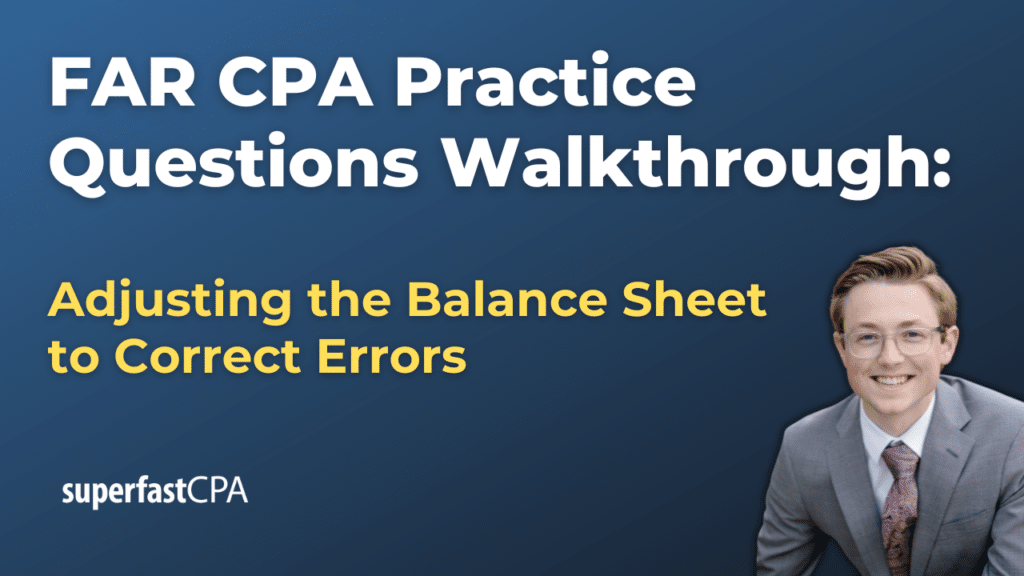In this video, we walk through 5 FAR practice questions teaching about adjusting the balance sheet to correct errors. These questions are from FAR content area 1 on the AICPA CPA exam blueprints: Financial Reporting.
The best way to use this video is to pause each time we get to a new question in the video, and then make your own attempt at the question before watching us go through it.
Also be sure to watch one of our free webinars on the 6 “key ingredients” to an extremely effective & efficient CPA study process here…
Adjusting the Balance Sheet to Correct Errors
The balance sheet is a fundamental financial statement that provides a snapshot of a company’s financial position at a specific point in time. It includes assets, liabilities, and shareholders’ equity. Accurate presentation of these elements is crucial for stakeholders’ decision-making. Occasionally, errors may occur during the preparation of the balance sheet, necessitating adjustments to correct these inaccuracies. This overview will discuss common types of balance sheet errors and provide detailed examples and explanations on how to adjust them.
Common Types of Balance Sheet Errors
- Misclassification Errors: These occur when an item is recorded in the wrong category. For instance, recording a long-term asset as a current asset.
- Omissions: Items that should be included in the balance sheet but were inadvertently left out, such as accrued expenses or unrecorded revenues.
- Duplication Errors: When a transaction is recorded more than once, leading to overstatement of an account.
- Incorrect Amounts: Recording an item with the wrong amount, either due to a typo or a calculation error.
Adjusting Misclassification Errors
Example: Elmwood Bank incorrectly recorded a $50,000 machinery purchase as inventory.
Initial Balances:
- Inventory: $200,000
- Machinery: $0
Correction:
- Decrease Inventory by $50,000
- Increase Machinery by $50,000
Adjusted Balances:
- Inventory: $150,000
- Machinery: $50,000
Explanation: Machinery should be classified as a fixed asset, not inventory. The adjustment corrects the classification, ensuring the balance sheet accurately reflects the company’s assets.
Adjusting Omissions
Example: Elmwood Bank received notification of $4,200 interest revenue earned in December but not recorded.
Initial Balances:
- Interest Receivable: $0
- Retained Earnings: $90,000
Correction:
- Increase Interest Receivable by $4,200
- Increase Retained Earnings by $4,200
Adjusted Balances:
- Interest Receivable: $4,200
- Retained Earnings: $94,200
Explanation: Interest revenue earned but not yet received should be recorded as Interest Receivable. This adjustment ensures that the balance sheet includes all revenues earned, accurately reflecting the company’s financial position.
Adjusting Duplication Errors
Example: Elmwood Bank duplicated a $10,000 loan payment.
Initial Balances:
- Loans Payable: $30,000
- Cash: $40,000
Correction:
- Increase Loans Payable by $10,000
- Increase Cash by $10,000
Adjusted Balances:
- Loans Payable: $40,000
- Cash: $50,000
Explanation: The loan payment was recorded twice, reducing Loans Payable and Cash more than necessary. The adjustment corrects this by reversing the duplicate entry.
Adjusting Incorrect Amounts
Example: A $25,000 prepaid insurance payment was incorrectly recorded as $2,500.
Initial Balances:
- Prepaid Insurance: $2,500
- Cash: $100,000
Correction:
- Increase Prepaid Insurance by $22,500
- Decrease Cash by $22,500
Adjusted Balances:
- Prepaid Insurance: $25,000
- Cash: $77,500
Explanation: The prepaid insurance payment amount was recorded incorrectly. The adjustment corrects the amount, ensuring that the balance sheet accurately reflects the company’s prepaid expenses and cash position.
Impact on Equity Accounts
Errors can also affect equity accounts, such as common stock, treasury stock, and additional paid-in capital (APIC). Correcting these errors is crucial for presenting an accurate picture of shareholders’ equity.
Example: Elmwood Bank issued $60,000 of common stock, which was incorrectly recorded as a loan payable.
Initial Balances:
- Common Stock: $100,000
- Loan Payable: $60,000
Correction:
- Increase Common Stock by $60,000
- Decrease Loan Payable by $60,000
Adjusted Balances:
- Common Stock: $160,000
- Loan Payable: $0
Explanation: The issuance of common stock should increase the Common Stock account, not Loan Payable. This adjustment corrects the misclassification, providing an accurate representation of the company’s equity and liabilities.
Conclusion
Adjusting the balance sheet to correct identified errors is essential for ensuring accurate financial reporting. It involves identifying the nature of the error—whether it’s a misclassification, omission, duplication, or incorrect amount—and making the necessary adjustments to the affected accounts. By doing so, companies can present a true and fair view of their financial position, which is crucial for stakeholders’ decision-making. Accurate balance sheets not only comply with accounting standards but also build trust with investors, creditors, and other users of financial statements.













